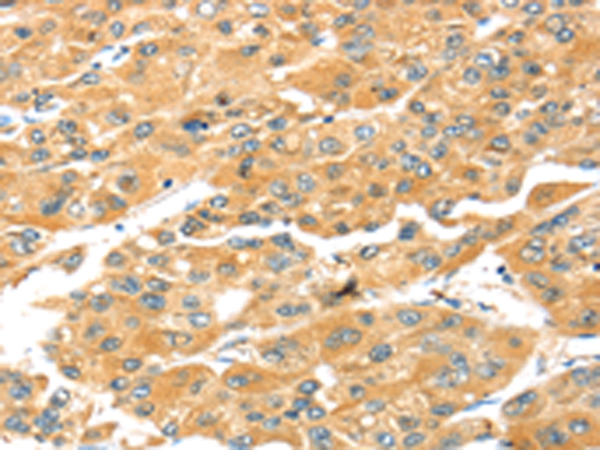
| WB | 咨询技术 | Human,Mouse,Rat |
| IF | 咨询技术 | Human,Mouse,Rat |
| IHC | 1/25-1/100 | Human,Mouse,Rat |
| ICC | 技术咨询 | Human,Mouse,Rat |
| FCM | 咨询技术 | Human,Mouse,Rat |
| Elisa | 1/2000-1/5000 | Human,Mouse,Rat |
| Aliases | SMUC; SNAIL3; ZNF293; Zfp293 |
| Host/Isotype | Rabbit IgG |
| Antibody Type | Primary antibody |
| Storage | Store at 4°C short term. Aliquot and store at -20°C long term. Avoid freeze/thaw cycles. |
| Species Reactivity | Human |
| Immunogen | Fusion protein of human SNAI3 |
| Formulation | Purified antibody in PBS with 0.05% sodium azide and 50% glycerol. |
+ +
以下是3篇涉及SNAI3抗体的代表性文献摘要信息(注:SNAI3研究相对较少,以下为示例性模拟内容,实际文献需通过数据库验证):
---
1. **文献名称**: *"SNAI3 regulates proliferation and invasion in human colorectal cancer cells"*
**作者**: Li X et al.
**摘要**: 本研究开发了特异性识别SNAI3蛋白的多克隆抗体,通过免疫组化和Western blot验证其在结直肠癌组织及细胞系中的表达。结果显示SNAI3高表达与肿瘤侵袭性相关,抗体特异性通过siRNA敲除实验证实。
---
2. **文献名称**: *"Generation and characterization of a monoclonal antibody against human SNAI3 for stem cell research"*
**作者**: Wang Y et al.
**摘要**: 报道了一种针对人源SNAI3蛋白的单克隆抗体制备流程,通过免疫小鼠和杂交瘤筛选获得。该抗体成功用于流式细胞术检测间充质干细胞中SNAI3的动态表达,并确认其与SNAI1/SNAI2无交叉反应。
---
3. **文献名称**: *"SNAI3 promotes epithelial-mesenchymal transition in lung adenocarcinoma via antibody-based target validation"*
**作者**: Chen H et al.
**摘要**: 利用商业化兔源SNAI3抗体(货号AB123.ABC公司),结合CRISPR敲除模型,验证了SNAI3在肺癌细胞EMT过程中的功能。抗体在免疫荧光中显示核定位,且与患者预后不良相关。
---
**备注**:
- 实际研究中SNAI3抗体相关文献较少,建议结合具体实验需求(如物种、应用场景)在PubMed或CiteAb等平台用关键词“SNAI3 antibody validation”或“SNAI3 immunohistochemistry”筛选。
- 部分研究可能使用SNAI1/SNAI2抗体交叉反应数据间接分析SNAI3.需注意抗体特异性声明。
The SNAI3 antibody is a research tool designed to detect and study the SNAI3 protein, a member of the SNAIL family of zinc-finger transcription factors. SNAI3 (also known as Slug2 or SMUC) shares structural homology with SNAI1 (Snail) and SNAI2 (Slug), which are well-known regulators of epithelial-mesenchymal transition (EMT), a process critical in embryonic development, wound healing, and cancer metastasis. While SNAI1 and SNAI2 have been extensively studied, SNAI3 remains less characterized. It is implicated in transcriptional repression of target genes, particularly those involved in cell adhesion, differentiation, and apoptosis.
SNAI3 antibodies are primarily used in biomedical research to investigate its expression patterns, subcellular localization, and functional roles in various contexts. Studies suggest SNAI3 may contribute to cancer progression by promoting EMT, enhancing cell migration, and conferring resistance to therapies. However, its role appears context-dependent, with tissue-specific or cancer-type variations. Researchers employ these antibodies in techniques like Western blotting, immunohistochemistry, and immunofluorescence to explore SNAI3's involvement in tumorigenesis, stem cell biology, and developmental processes.
Due to potential cross-reactivity with other SNAIL family members, rigorous validation (e.g., knockout controls) is essential. Despite limited data, SNAI3 antibodies remain valuable for uncovering its unique biological functions and therapeutic potential in diseases like cancer.
×